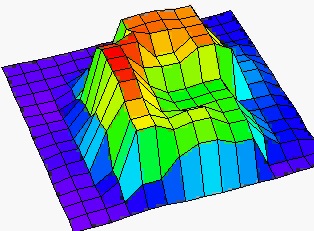Evidence for apical constriction comes from several
sources. Here the vegetal plate in L. pictus has
been stained with phalloidin to reveal actin
microfilaments. The arrows point to two regions of
constriction that make local "kinks" in the vegetal
plate.
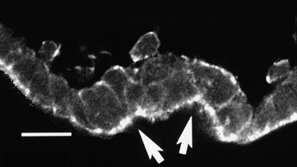
Image by Jeff Hardin, Univ. of Wisconsin
Robert Burke and colleagues at the University of Victoria were the first to show that a dense localization of actin is present in these apically constricted cells in S. purpuratus. The picture below, from our laboratory, shows a S. purpuratus gastrula.
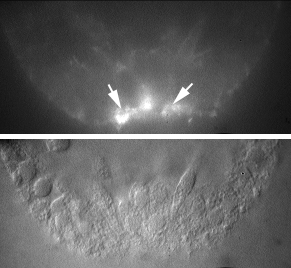
Image by Beth Laxson and Jeff Hardin, Univ. of Wisconsin.
The picture below is a scanning electron micrograph of a comparable vegetal plate in L. pictus, which also shows the kinks at locations of bottle cells formation.
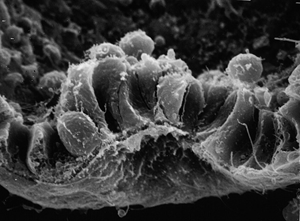
Image by Jeff Hardin, Univ. of Wisconsin.
Since these are sagittal sections through the vegetal plate, if these cells formed all the way around the vegetal plate, we would expect a ring of such cells if we could look at the surface of the vegetal plate from the bottom (i.e., the vegetal pole). By manually tipping embryos under a dissecting microscope so that their vegetal plates are parallel to the coverslip, we can actually see that a ring of apically constricted cells does form as the vegetal plate begins to invaginate.
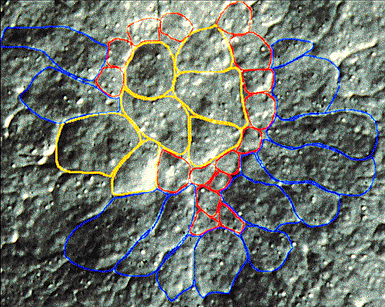
Image by Beth Laxson and Jeff Hardin, Univ. of Wisconsin.
By using a laser microbeam, we can ablate various populations of cells in the vegetal plate in "tipped" embryos to assess which cells are necessary for invagination. Beth Laxson in our laboratory has ablated bottle cells and shown that they are necessary during the initiation of primary invagination. Below is a 3-d graph of the depth of invagination in an embryo in which a 120 degree arc of bottle cells has been ablated. Note the the ablated region doesn't invaginate nearly as far. This is consistent with a role for bottle cells in initiating invagination. Click on the thumbnail to see a movie of this graph that allows you to rotate to see which regions are less invaginated.

Image by Jeff Hardin, Univ. of Wisconsin
Robert Burke and colleagues at the University of Victoria were the first to show that a dense localization of actin is present in these apically constricted cells in S. purpuratus. The picture below, from our laboratory, shows a S. purpuratus gastrula.

Image by Beth Laxson and Jeff Hardin, Univ. of Wisconsin.
The picture below is a scanning electron micrograph of a comparable vegetal plate in L. pictus, which also shows the kinks at locations of bottle cells formation.

Image by Jeff Hardin, Univ. of Wisconsin.
Since these are sagittal sections through the vegetal plate, if these cells formed all the way around the vegetal plate, we would expect a ring of such cells if we could look at the surface of the vegetal plate from the bottom (i.e., the vegetal pole). By manually tipping embryos under a dissecting microscope so that their vegetal plates are parallel to the coverslip, we can actually see that a ring of apically constricted cells does form as the vegetal plate begins to invaginate.

Image by Beth Laxson and Jeff Hardin, Univ. of Wisconsin.
By using a laser microbeam, we can ablate various populations of cells in the vegetal plate in "tipped" embryos to assess which cells are necessary for invagination. Beth Laxson in our laboratory has ablated bottle cells and shown that they are necessary during the initiation of primary invagination. Below is a 3-d graph of the depth of invagination in an embryo in which a 120 degree arc of bottle cells has been ablated. Note the the ablated region doesn't invaginate nearly as far. This is consistent with a role for bottle cells in initiating invagination. Click on the thumbnail to see a movie of this graph that allows you to rotate to see which regions are less invaginated.
